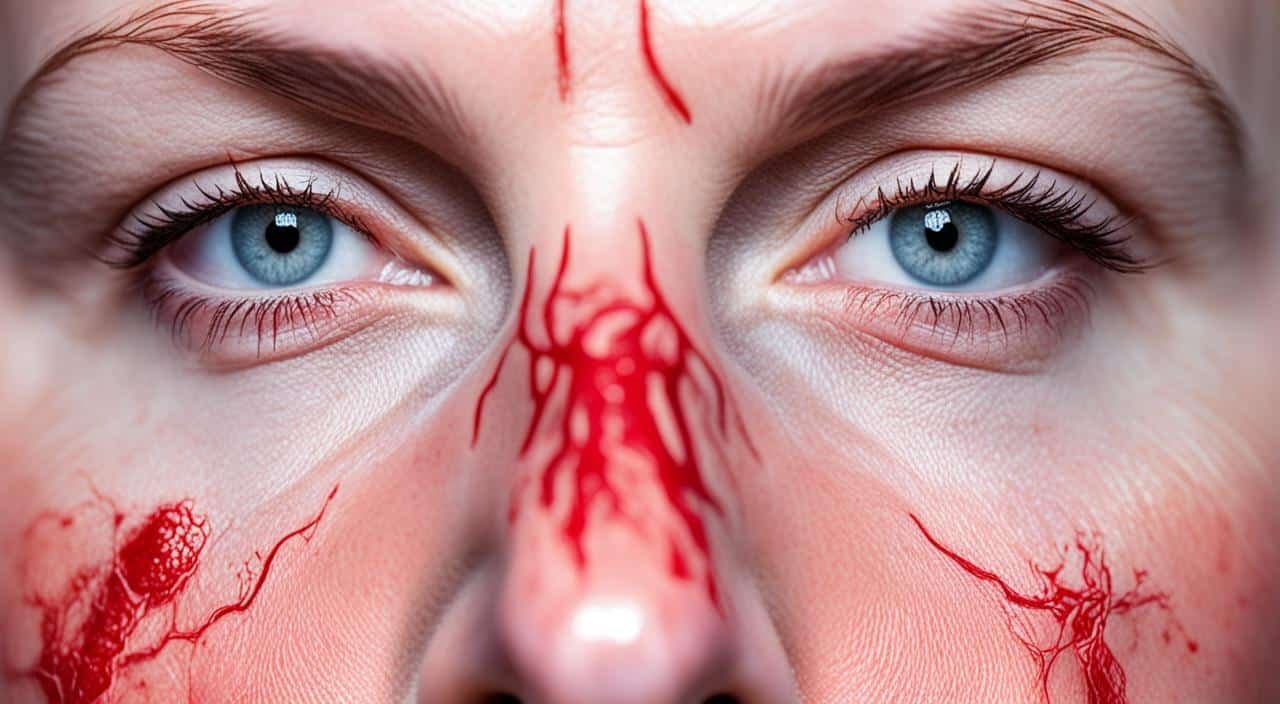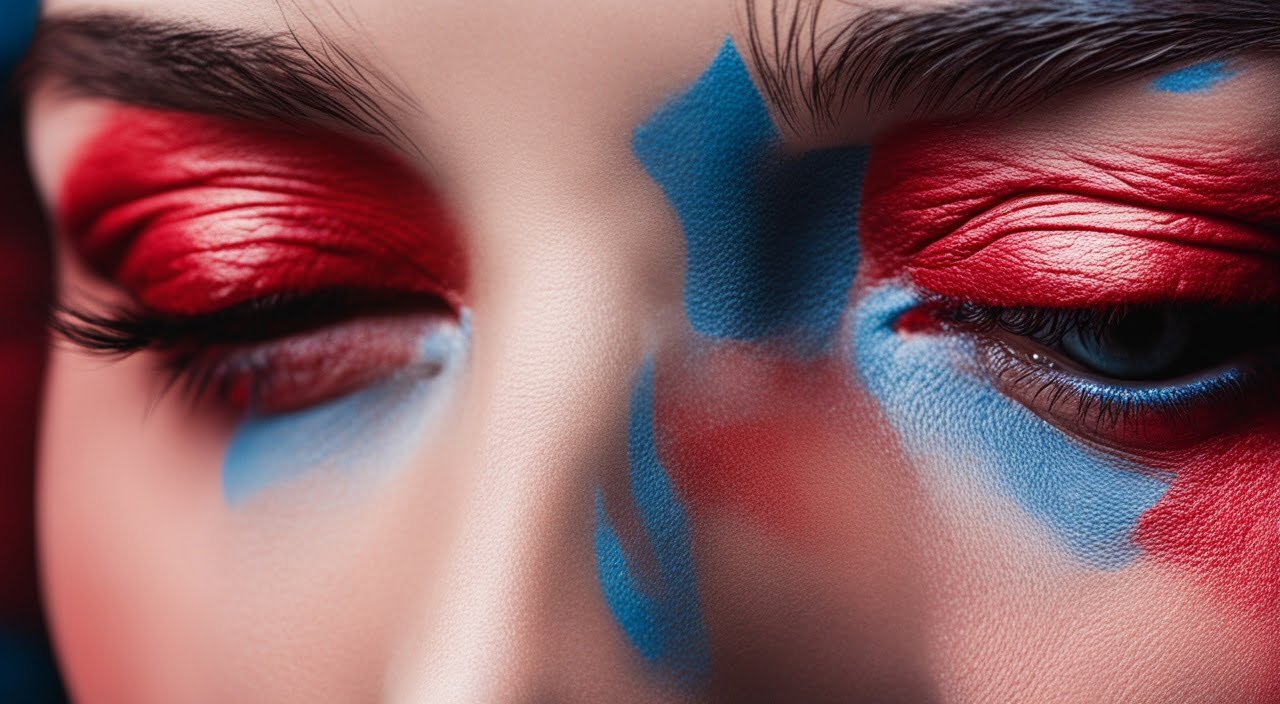Rosacea is a common skin condition that affects millions of people worldwide. It’s known for causing persistent redness on the face and other symptoms that can affect how people feel about their appearance. Knowing the signs of rosacea is key to catching it early and managing it well.
Many people confuse rosacea with acne, so it’s important to know the real signs. The main symptoms include redness and flushing that can be set off by many things. This redness often shows up as visible blood vessels, small bumps, and in bad cases, skin thickening on the nose.
Rosacea can also hit the eyes, causing irritation, dryness, and a burning feeling. This can really affect someone’s daily life and overall happiness.
Key Takeaways
- Rosacea is a common skin condition that causes ongoing facial redness and flushing.
- Visible blood vessels, small pus-filled bumps, and skin thickening are other common symptoms of rosacea.
- Rosacea can also affect the eyes, leading to ocular rosacea with symptoms like irritation and dryness.
- Rosacea is often mistaken for other skin conditions, highlighting the need for early diagnosis and proper care.
- Understanding rosacea’s symptoms is vital for those affected to get the right treatment and manage their condition well.
Understanding Rosacea: An Overview
Rosacea is a chronic skin condition that mainly affects the face. It causes ongoing redness, visible blood vessels, and other symptoms. It’s a common issue, impacting about 16 million Americans, but its exact cause is still unknown.
Defining Rosacea and its Impact
Rosacea is a skin condition that can greatly affect a person’s life and confidence. It’s marked by redness, flushing, and visible blood vessels on the face. These can also come with bumps, pimples, and skin thickening.
Who is at Risk of Developing Rosacea?
- Individuals with fair skin
- People between the ages of 30 and 50
- Those with a family history of rosacea
Rosacea is a chronic skin condition that can be managed with the right treatment and lifestyle changes. It’s crucial to see a doctor for an accurate diagnosis and tailored care.
“Rosacea is a common, chronic skin condition that can have a significant impact on a person’s quality of life and self-confidence.”
The Visible Signs of Rosacea

Rosacea is a common skin condition that shows up in many ways. The most obvious signs are constant redness and flushing on the face. This redness can start as easy blushing but can become a lasting feature. Many people with rosacea also see spider veins on their nose and cheeks.
Also Read : How Can You Apply For Scholarships At Stanford University?
Persistent Facial Redness and Flushing
Rosacea is known for its constant redness and flushing. This redness can be mild or very noticeable on the cheeks, nose, forehead, and chin. It can be set off by things like the sun, spicy foods, hot drinks, stress, and changes in the weather.
Visible Blood Vessels on the Face
People with rosacea often see small, dilated blood vessels on their nose and cheeks. These spider veins can make the skin look uneven over time. How easy they are to see depends on your skin tone and how bad your rosacea is.
Knowing what rosacea looks like is key to dealing with it. By spotting the signs, people can get help and find treatments. This can make rosacea less noticeable and more manageable.
Rosacea
Rosacea is a chronic skin condition that mainly affects the face. It causes visible symptoms. The exact causes are not known, but it might be linked to inflammation and triggers like sun exposure, stress, and certain foods. There is no cure, but treatments and lifestyle changes can help manage it.
Rosacea is known for persistent facial redness, visible blood vessels, flushing, and sometimes small, pus-filled bumps. Symptoms can change, making it hard to predict. Knowing what triggers it and how to manage symptoms is crucial for those with rosacea.
Causes and Risk Factors
The exact causes of rosacea are still unknown. It’s thought to be a mix of genetic and environmental factors. Some possible causes include:
- Inflammation and immune system issues
- Sun exposure and UV radiation
- Emotional stress and changes in temperature or weather
- Certain foods and beverages, like spicy or hot items
- Medications that widen blood vessels
Rosacea is more common in people with fair skin. It usually starts in adults between 30 and 50. Women are more likely to get it than men.
Treatment Options
There is no cure for rosacea, but many treatments can help. These include:
- Topical medications, like creams or gels with metronidazole or azelaic acid
- Oral medications, such as antibiotics or anti-inflammatory drugs
- Laser or light-based therapies to reduce redness and visible blood vessels
- Lifestyle changes, like avoiding triggers, using gentle skin care products, and protecting the skin from sun exposure
Working closely with a dermatologist is key to finding the right treatment plan. This plan should address your specific symptoms and triggers.
“Rosacea is a complex and chronic skin condition that can have a significant impact on an individual’s quality of life. By understanding the symptoms, causes, and available treatments, people with rosacea can take steps to manage their condition and improve their overall skin health.”
Also Read : What Are The Steps In The Best University Admissions?
Skin Rash and Bumps Associated with Rosacea
Rosacea often leads to skin rashes and small, pus-filled bumps that look like acne. This type of rosacea, called papulopustular rosacea, can be hard on those who have it. These skin rashes and bumps can make people feel self-conscious. But, taking good care of your skin and seeing a doctor are key to handling this part of the condition.
People with papulopustular rosacea see skin rashes and bumps that look like acne. But, they are not the same thing. Knowing the difference is important for the right treatment. It helps manage the skin problems better.
Using gentle cleansers and moisturizers can calm irritated skin and lessen the look of rosacea-related skin rashes and bumps. Seeing a dermatologist is a good idea to find treatments like creams or pills. These can help with papulopustular rosacea and make skin healthier.
“Addressing the skin rashes and bumps associated with rosacea is an important aspect of managing the condition and improving the patient’s quality of life.”
Knowing how rosacea leads to skin rashes and bumps helps people take steps to get the right medical care. It also helps them use good skin care routines to lessen these symptoms.
Also Read : What University Degree Programs Can You Study At Howard University?
Thickening and Enlargement of the Skin
Rosacea is a chronic skin condition that can make the skin thicker and the nose bigger. This is called rhinophyma. It makes the nose look bulbous and bigger. It happens more in men than women and is a severe form of rosacea.
Rhinophyma: The Bulbous Nose
As rosacea gets worse, the glands on the nose grow bigger. This leads to skin thickening and nose enlargement. The nose can look bulbous and rough, like a “bulbous nose.”
Treating rhinophyma can include laser therapy or surgery. But, it’s key to deal with the rosacea first. This helps stop more skin thickening and nose enlargement. By tackling the cause, people can feel better and stop this severe rosacea effect.
“Rhinophyma is one of the more severe and visible signs of uncontrolled rosacea, leading to a significant impact on the individual’s appearance and self-confidence.”
Eye Problems and Ocular Rosacea
Rosacea is a chronic skin condition that affects more than just the face. Many people with rosacea also face eye problems, known as ocular rosacea. These eye issues can cause a variety of problems. It’s crucial to see a doctor quickly.
Symptoms of Ocular Rosacea
The main signs of ocular rosacea are:
- Dry, irritated eyes – The eyes may feel gritty, burning, or stinging. These feelings get worse with wind or bright light.
- Swollen eyelids – The eyelids can become red, inflamed, and puffy, causing discomfort.
- Development of styes – Small, painful bumps may form on the eyelid, often from blocked oil glands.
Importance of Seeking Treatment
If not treated, ocular rosacea can cause serious eye problems, including vision loss. In severe cases, it can even lead to blindness. Early treatment is key to preventing these issues and keeping eyes healthy.
People with rosacea who notice eye problems should see an eye care professional. This includes ophthalmologists or optometrists. They can give a full check-up and a treatment plan tailored to you. Quick medical care can ease discomfort and prevent eye problems from getting worse.
Also Read :What Are The Best Universities In The Us?
The Cyclical Nature of Rosacea Symptoms

Rosacea is a chronic skin condition that has its ups and downs. People with rosacea often see their symptoms get worse and then better. This cycle can be tough, but knowing it helps manage rosacea and spot triggers.
When rosacea flares up, it can make your face red, show blood vessels, and cause bumps or pimples. Many things can trigger these flare-ups, like being in the sun, feeling stressed, or eating certain foods. But, these flare-ups will pass, and symptoms can fade or go away.
This cycle shows why seeing a doctor and working with them is key. By understanding rosacea, people can plan for flare-ups and lessen their impact on daily life.
“Rosacea is a chronic, relapsing skin condition that can significantly impact an individual’s quality of life. Understanding the cyclical nature of the condition is key to developing effective management strategies.”
Along with doctor’s advice, making lifestyle changes helps too. Avoiding triggers, using gentle skin products, and reducing stress can help. By being proactive, people with rosacea can lessen flare-ups and keep their skin healthier.
| Characteristic | Description |
|---|---|
| Chronic Condition | Rosacea is a long-lasting skin condition that can come and go over time. |
| Flare-ups | Periods of time when rosacea symptoms worsen, such as increased facial redness and visible blood vessels. |
| Remission | Periods of time when rosacea symptoms subside or disappear entirely. |
| Triggers | Factors that can contribute to rosacea flare-ups, such as sun exposure, stress, and certain foods. |
Recognizing Potential Triggers
Rosacea is a chronic skin condition that can get worse with certain things. Knowing what can make it worse is key to controlling the symptoms.
Environmental and Lifestyle Factors
Some things in our environment and lifestyle can make rosacea worse. These include:
- Sun exposure: Too much UV light can make rosacea symptoms worse, causing more redness and swelling.
- Hot drinks: Drinking hot coffee, tea, or hot chocolate can also make rosacea worse.
- Spicy foods: Eating spicy or strong-tasting foods can make blood vessels expand, causing more redness.
- Alcohol: Drinking alcohol, especially red wine, can also make rosacea symptoms worse by widening blood vessels.
- Certain medications: Some drugs like corticosteroids or blood pressure medications can also make rosacea symptoms worse.
Emotional Stress and Its Impact
Emotional stress can also trigger rosacea flare-ups. Stress can cause blood flow and inflammation, making rosacea symptoms worse.
By avoiding these triggers, people with rosacea can manage their condition better. Talking to a healthcare professional can help find and deal with specific triggers. This can improve skin health and overall quality of life.
Also Read :How Can Exercise Help With Anxiety?
Seeking Medical Attention for Rosacea

If you notice your face often gets red or flushes, you should see a doctor. A dermatologist can help with rosacea. Getting help early is key to managing the condition and stopping it from getting worse.
There’s no cure for rosacea, but there are ways to control it. Doctors can suggest treatment options like creams, pills, and changes in your daily life. These can help make your skin look better and feel healthier.
Importance of Early Diagnosis
Spotting rosacea early is very important. It lets doctors start treatment right away. This can stop the condition from getting worse and reduce risks like seeing more blood vessels or thicker skin.
Seeing a dermatologist means you get a detailed check-up and a plan just for you. They can help you manage your rosacea better. This can make your skin look and feel better, lessen symptoms, and improve your life quality.
“Early diagnosis and treatment are key to managing rosacea and preventing it from worsening over time.”
Getting help for rosacea quickly can also protect your feelings and confidence. It can stop the condition from affecting how you feel about yourself. By acting fast, you can take charge of your skin and feel better overall.
Distinguishing Rosacea from Other Skin Conditions
Rosacea is a common skin issue that often gets mixed up with acne or dermatitis. These conditions may look similar, but getting a proper diagnosis from a healthcare expert is key. This ensures you get the right treatment and care.
Rosacea is marked by ongoing redness on the face, visible blood vessels, and sometimes small, red bumps or pimples. On the other hand, acne shows up as blackheads, whiteheads, and big, inflamed spots. Dermatitis often causes dry, itchy, and flaky skin.
A dermatologist can tell rosacea apart from these other skin problems with a detailed check-up. They might also do more tests if needed. Getting the right diagnosis is important. The treatment for rosacea is quite different from that for acne or dermatitis.
| Skin Condition | Primary Symptoms | Treatment Approach |
|---|---|---|
| Rosacea | Persistent facial redness, visible blood vessels, small bumps | Topical medications, oral antibiotics, lifestyle modifications |
| Acne | Blackheads, whiteheads, larger inflamed blemishes | Topical creams, oral medications, hormonal therapy |
| Dermatitis | Dry, itchy, flaky skin | Moisturizers, anti-inflammatory creams, avoidance of triggers |
Knowing how rosacea is different from other skin issues helps people get the right medical care. This way, they can manage their skin health better.
Also Read: Why Prestige Healthcare Is The Ultimate Health Investment?
Conclusion
Rosacea is a chronic skin condition that can really affect someone’s life. There’s no cure, but knowing about symptoms, triggers, and treatments can help manage it. This can lessen flare-ups.
Getting help early and working with doctors is key for rosacea control. This way, people with rosacea can make a plan to handle their symptoms. They can keep their skin healthy and looking good.
Managing rosacea means looking at many things like the environment and lifestyle. It also means trying out medical treatments. With a good plan, people with rosacea can improve their lives. By being careful and working with their doctors, they can control their symptoms and keep their skin healthy.
FAQs
Q: What are the symptoms of rosacea?
A: Symptoms of rosacea may include facial redness, visible blood vessels, swelling, and thickened skin. Some patients with rosacea may also experience eye symptoms like redness, dryness, and irritation.
Q: How is rosacea diagnosed?
A: Rosacea is diagnosed based on a physical examination of the skin and a discussion of the patient’s medical history. In some cases, a skin biopsy may be performed to rule out other conditions.
Q: What is the treatment for rosacea?
A: Treatment for rosacea may involve lifestyle changes, topical medications, oral antibiotics, laser therapy, or light therapy. The approach to treatment may vary depending on the type and severity of rosacea.
Q: What are the causes of rosacea?
A: The cause of rosacea is unknown, but factors such as genetics, environmental triggers, and abnormalities in the blood vessels of the face may contribute to its development. Identifying and avoiding triggers can help manage symptoms.
Q: What are the complications of rosacea?
A: Complications of rosacea may include thickened skin, particularly on the nose (phymatous rosacea), eye problems, and emotional distress due to changes in physical appearance. Early diagnosis and treatment can help prevent these complications.
Q: How can rosacea be prevented?
A: Preventing rosacea involves identifying and avoiding triggers that worsen symptoms. These triggers may include sun exposure, hot beverages, spicy foods, alcohol, and stress. Gentle skin care and using sunscreen can also help prevent flare-ups.
Q: What are the different types of rosacea?
A: The main types of rosacea are erythematotelangiectatic rosacea (characterized by facial redness and visible blood vessels), papulopustular rosacea (marked by acne-like bumps), phymatous rosacea (resulting in thickened skin and enlargement of facial features), and ocular rosacea (affecting the eyes).
Source Links
- https://www.niams.nih.gov/health-topics/rosacea
- https://my.clevelandclinic.org/health/diseases/12174-rosacea
- https://www.mayoclinic.org/diseases-conditions/rosacea/symptoms-causes/syc-20353815




